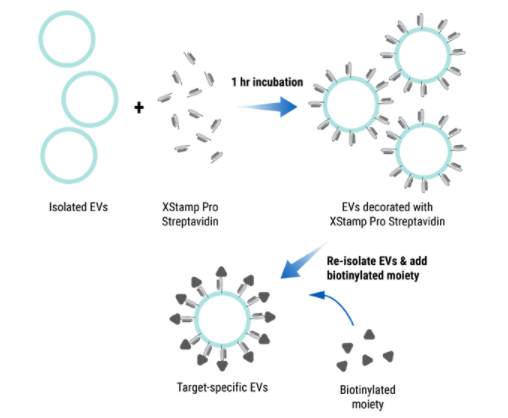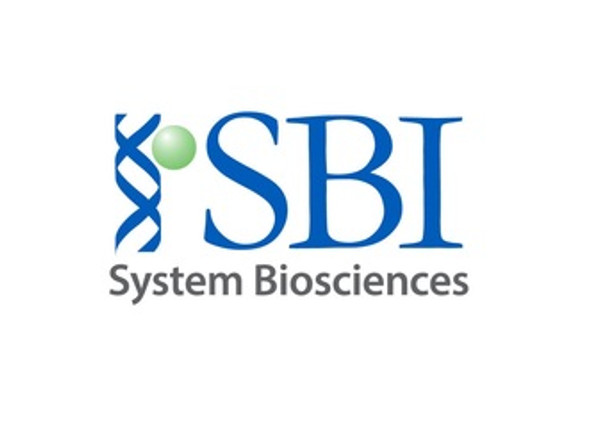System Biosciences
XStamp Pro Streptavidin Customizable EV Targeting Kit
- SKU:
- XSTP900A-1
- Availability:
- Usually Shipped in 5 Working Days
- Size:
- 10 rxn
- Shipping Temperature:
- Dry Ice
Description
XStamp Pro Streptavidin Customizable EV Targeting Kit. Cat# XSTP900A. Supplier: SBI System Biosciences
- Speed production of target-specific EVs with the next generation of XStamp technology
- Streamline engineering by working directly with purified EVs—no expression vector or transfection required
- Choose what you target and how you target by using any biotinylated moiety
- Save hands-on time with a simple workflow—just incubate EVs with XStamp Pro Streptavidin for one hour, add a biotinylated targeting moiety, and isolate target-specific EVs
- Easily generate multiple targeting variants for quick screening studies
Products

Overview
Creating target-specific EVs just got a whole lot easier
The XStamp™ Pro Streptavidin EV Targeting Kit gives you virtually unlimited target specificity options. Just decorate the outside of your extracellular vesicles (EVs) with XStamp Pro Streptavidin and then attach the biotinylated targeting moiety partner of your choice, such as a biotinylated ScFv antibody. (See Table 1 for the pre-made XStamp Pro options). Save time and simplify your EV engineering workflow with XStamp Pro.
While conventional methods for creating target-specific EVs are highly robust (see our XStamp Cloning and Expression Lentivector, Cat# XSTP710PA-1), they involve cloning and manipulation of the producer cells which can be challenging, especially if the cells are hard to transfect. To streamline this process and help researchers more quickly and easily create EVs that preferentially localize to a specific target, SBI turned to an exciting new technology, XStamp Pro, which works on already purified EVs—no cloning or transfection required. Simply incubate purified EVs with the XStamp Pro reagent for one-hour and then isolate your target-specific EVs.
- Speed production of target-specific EVs with the next generation of XStamp technology
- Streamline engineering by working directly with purified EVs—no expression vector or transfection required
- Choose what you target and how you target by using any biotinylated moiety
- Save hands-on time with a simple workflow—just incubate EVs with XStamp Pro Streptavidin for one hour, add a biotinylated targeting moiety, and isolate target-specific EVs
- Easily generate multiple targeting variants for quick screening studies
- Compatible with any EV loading protocol
Each XStamp Pro Streptavidin Kit comes with enough XStamp Pro Streptavidin for 10 reactions* and ExoQuick®-TC for EV isolation. Once the reaction is complete and your streptavidin-coated EVs are isolated, they are ready for addition of the biotinylated moiety, cargo-loading, and cargo delivery.
For even faster workflows, you can use Exo-Fect siRNA/miRNA EV Transfection Reagent (Cat.# EXFT200A-1) or the original Exo-Fect Reagent (Cat.# EXFT10A-1 /20A-1) to load cargo into isolated EVs before adding the targeting specificity with XStamp Pro.

How It Works
Engineer target specificity into already-purified EVs
XStamp Pro takes advantage of the same EV surface-directing protein used in our original XStamp products but skips the expression vector and stable cell line generation for a faster, simpler workflow. You get an already purified peptide consisting of the streptavidin fused to the EV surface-directing protein—the XStamp Pro Streptavidin.
Figure 1. The streamlined XStamp Pro Streptavidin workflow.
Supporting Data
See how effective XStamp Pro Streptavidin is at delivering cargo

Figure 2. EVs engineered using XStamp Pro St
ind EVs but not biotinylated atto-488 dye, we show that there is no fluorescence from beads alone (top row), beads with biotinylated atto-488 (second row), or beads with biotinylated atto-488 and untreated EVs (third row). Only EVs decorated with XStamp Pro Streptavidin (bottom row) can bind biotinylated atto-488 and, thus, fluoresce.

Figure 3. EVs engineered using XStamp Pro Streptavidin and biotinylated anti-CCR5 efficiently target CCR5+ cells and are internalized. We labeled serum-derived EVs with ExoGlow Green EV labeling dye (Cat.# EXOGP300A-1), treated labeled EVs with XStamp Pro Streptavidin to decorate EV surfaces with streptavidin, and then added biotinylated anti-CCR5 antibody to target the EVs to CCR5+ cells. After incubation with unactivated CD4+ T cells, which express CCR5, we stained the cells for CCR5 using phycoerythrin (PE), and examined the cells using flow cytometry.
While cells treated with non-targeting ExoGlow Green-labeled EVs do take up EVs, this uptake is non-specific as it is independent of CCR5 status (bottom left plot). When cells are treated with EVs specific for CCR5, almost all of the ExoGlow Green label is restricted to CCR5+ cells (bottom right plot, top right quadrant), demonstrating the specificity and efficiency of the EV targeting. Data courtesy of Pooja Bhardwaj and Satish Pillai, UCSF















